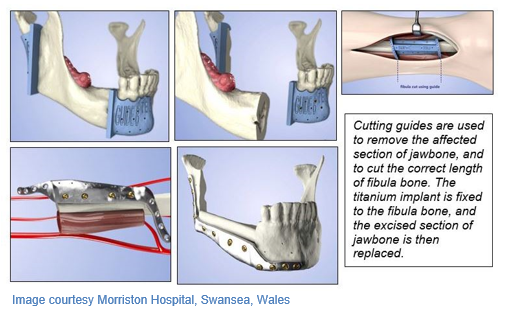 A Welch surgical team has performed the first jaw reconstruction surgery using 3D printed titanium specifically designed for the patient, resulting in much more natural result.
A Welch surgical team has performed the first jaw reconstruction surgery using 3D printed titanium specifically designed for the patient, resulting in much more natural result.
Surgery for oral cancer often leaves patients disfigured and unable to speak normally. Standard reconstructive surgery involves removing a part of the patient’s fibula and fitting it into the space made in the jawbone excised to remove the tumor.
Fitting the bone into place is an intricate procedure that requires connecting the blood vessels serving the bone to blood vessels in the patient’s neck. The surgery normally takes more than 8 to 10 hours, a long time to be under anesthesia, and often results in a jaw without teeth.
The problem is that to retain the natural shape of the patient’s jaw, the implant has to be set too low to allow for teeth implants, or the implant can be set high enough to accept teeth implants, but the natural jaw shape is lost.
In addition, the surgeon often spends a significant amount of time trimming and shaping the bone to fit, and then fashioning a metal plate and bending it to the correct position to hold the implant in place.

The British surgeons at Morriston Hospital in Swansea, Wales, used CT imaging to make precisely measured guides to allow cutting the bone from the fibula to perfectly fit the excised jawbone space.
At the same time, CT imaging data is converted to a 3D model on a computer that the technician uses to ensure the precise geometry needed. The 3D optical laser printer then constructs the titanium implant using titanium powder fused by laser into the precise geometry micro layer by micro layer.
Led by surgeon Madhav Kittur, and assisted by Maxillofacial Laboratory Services Manager Peter Llewelyn Evans and Biomedical 3D Technician Heather Goodrum, the team published the technical information on the procedure in the British Journal of Oral and Maxillofacial Surgery.
“The titanium implant fits the patient’s jaw perfectly without the surgeon having to do any adjustment,” Evans said in a press release. “Similarly, using cutting guides means the section of fibula exactly matches the section of jawbone removed.”
The team has since completed five more reconstructions using the 3D printing technique and are planning a sixth. It is a clear example of how 3D printing technology is creating a paradigm shift in how reconstructive surgery is performed.



